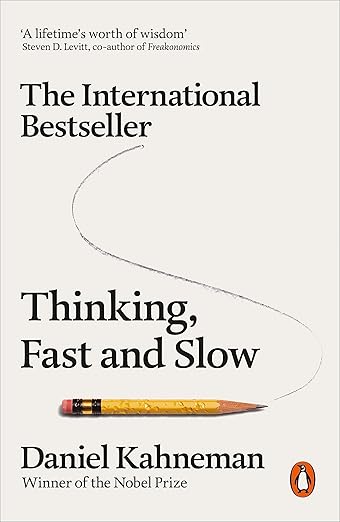“The planning fallacy is that you make a plan, which is usually a best-case scenario.” - Daniel Kahneman
My first thought when I saw when this book was published was what an amazing period the 2010's were for psychology and behavioural economics. That was fast-thinking. When I paused to reflect on that though , slow thinking, it was obvious that this was just the period when I was learning about it and therefore the books I've found helpful come from that period. Had I started that educational journey ten years either side, I have no doubt my collection of recommendations would look very different. Needless to say, that small moment shows why the ideas in this book are important. And, why I'd encourage anyone to recognise when they are thinking fast or slow.
Synopsis
Thinking, Fast and Slow by Daniel Kahneman is a truly insightful book that has significantly influenced how we understand human judgment and decision-making. Kahneman, a Nobel laureate in Economics, takes us on a fascinating journey through the workings of our minds.
The core idea of the book revolves around the concept of two distinct systems of thinking. He calls them System 1 and System 2.
System 1 is our “fast” thinking; it’s intuitive, automatic, emotional, and operates with little to no conscious effort. Think of it as the quick, gut reactions we have, like recognising a familiar face or solving a simple math problem like 2+2.
System 2, on the other hand, is our “slow” thinking; it’s more deliberate, logical, effortful, and requires conscious attention. This is what we engage when we’re solving complex problems, analysing data, or making difficult decisions.
Kahneman masterfully demonstrates that while System 1 is incredibly efficient and serves us well in many situations, it’s also prone to systematic errors and biases. These biases can lead us to make irrational judgments, even when we believe we’re being perfectly logical. He introduces us to a whole host of cognitive biases, such as confirmation bias, anchoring, and the availability heuristic, explaining how they influence our perceptions and choices in everyday life, from personal finance to medical diagnoses.
Ultimately, “Thinking, Fast and Slow” encourages us to become more aware of how our minds work. It’s not about saying one system is “better” than the other, but rather understanding their strengths and weaknesses. By recognising when we’re relying on our fast, intuitive thinking and when it might be more beneficial to engage our slower, more analytical processes, we can make more informed and effective decisions, both in our personal and professional lives and in our professional endeavours.
Key Points
- Two systems: fast and slow.
- Biases distort judgement.
- Heuristics simplify decisions.
- Awareness improves thinking.
- Intuition is often flawed.

